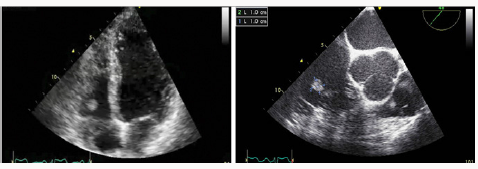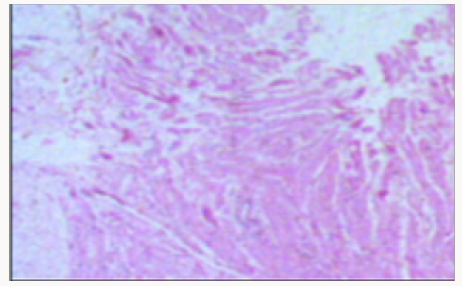
Lupine Publishers Group
Lupine Publishers
Menu
ISSN: 2637-6679
Case Report(ISSN: 2637-6679) 
Intracardiac Papillary Fibroelastoma: A Case Report Volume 1 - Issue 5
Luis Eduardo Silva1, Yennifer Suarez Tirado2, Andres Prada Rueda2, Arnold Méndez Toro1, Gustavo Palomino1 and Oscar Alfredo Pacheco1
- 1Internist, Cardiologist, Universidad Militar Nueva Granada-Hospital Militar Central, Bogotá, Colombia
- 2Internal Medicine Resident. Universidad Militar Nueva Granada-Hospital Militar Central, Bogotá, Colombia
Received: May 07, 2018; Published: May 14, 2018
Corresponding author: Luis Eduardo Silva, Internist, Cardiologist, Universidad Militar Nueva Granada-Hospital Militar Central, Bogotá, Colombia
DOI: 10.32474/RRHOAJ.2018.01.000123
Abstract
Most of primary cardiac masses correspond to benign tumors within which are the myxomas, rhabdomyomas and papillary fibroelastomas that occupy the third place in prevalence. These lesions are rare and are usually found incidentally in routine studies. More than 90% of papillary fibroelastomas occur in the heart valves, the most frequent being the aortic valve and the mitral valve. Echocardiography studies have reported a size between 2 and 40mm, mostly corresponding to single lesions, with a short pedicle, which present independent movement and are attached to an endocardial surface. The treatment is surgical since they can present complications like embolism to the pulmonary or systemic circulation, significant hemodynamic obstruction and death secondary to these embolic events. We present the case of an asymptomatic patient in whom a papillary fibroelastoma located in the tricuspid valve was documented, which was successfully resected.
Keywords: Cardiac tumors; papillary fibroelastomas; Embolism; Echocardiography
Introduction
Heart tumors include a wide number of lesions that may be of neoplastic or non neoplastic origin. Primary benign lesions are approximately 90% of primary heart tumors, including myxomas, rhabdomyomas, fibroids, and lipomas, among others [1]. Metastatic lesions are more frequent than primary lesions, found in nearly 18% of stage IV cancer [2]. Most heart tumors are incidentally found during routine cardiac imaging, and their prevalence in autopsy series is less than 0.1% [3-5]. Patients with primary tumors are usually asymptomatic until lesions grow large and generate symptoms related to mechanical obstruction, valve interference, alterations in contractility or in the electrical conduction system, generating arrhythmias and blockages [1,6]. Papillary fibroelastoma is the third most prevalent primary tumor after myxoma and rhabdomyoma. It may compromise valve surface, although cases of compromised interventricular or interatrial septum have also been reported [6,7]. Next we present the case of an asymptomatic patient with papillary fibroelastoma in the tricuspid valve, which was successfully resected.
Case Background
51-year-old man with a history of controlled hypertension and an active smoker, asymptomatic from a cardiovascular point of view who underwent a transthoracic echocardiogram during his routine checkup in his hometown. The exam revealed a mass attached to the tricuspid valve, and thus the patient was referred to our hospital for assessment. He was hemodynamically stable when he checked in at Hospital Militar Central (HMC), with no abnormal findings after physical examination and with normal range of laboratories and preoperative electrocardiogram values. After checking in at the HMC, the patient underwent a transesophageal echocardiogram to better characterize the lesion, which revealed a 11mm x 11 mm rounded, pedunculated mass of endocardial density in the lateral valve (Figure 1), without regurgitation and with preserved ejection fraction of the left ventricle (63%). The remainder of the description of this study was normal. Both the transthoracic and the transesophageal projection show a 11mm x 11 mm rounded, pedunculated mass of endocardial density in the anterior tricuspid valve. The subject underwent additional presurgical testing in the form of a coronary angiography, which revealed epicardial arteries without angiographically significant lesions. The patient’s case was submitted to the Board of Cardiology and to the cardiovascular surgery service, and it was concluded that he was suitable for surgery. The histopathological study of the sample taken in surgery was reported as papillary fibroelastoma type myxoid tissue mass of mesenchymal origin with a low degree of malignancy (Figure 2). The patient evolved without complications during the postoperative period and was discharged after 7 days of hospitalization.
Discussion
Heart tumors or masses are rare lesions that are documented parenthetically when performing a routine cardiac imaging. They can be classified into neoplastic and non-neoplastic tumors, the former being 20 to 50 times more frequent than primary tumors [1,7,8]. The prevalence of primary tumors is very low, being between 0.001 and 0.03% according to reports in autopsy series; as for neoplastic cardiac lesions, they can be found in about 18% of stage IV cancer patients [2-5]. Most primary heart tumors are benign, myxomas being the most frequent in adults, while rhabdomyoma is the most common in children. The third most frequent primary heart tumor in adults is the papillary fibroelastoma, which can be generated on any surface of the endocardium, being more commonly located in the heart valves. It makes up less than 10% of all cardiac tumors and is the most common valve tumor [5,8,9]. Papillary fibromyosarcomas are benign proliferations consisting of soft fibroblasts and variable collagenized stroma derived from the endocardium. They can occur at any age, but are more common in adults between 70 and 80 years. Over 90% of fibroelastomas occur in the heart valves, and close to 10% happen in non-valvular surfaces, such as the interventricular or interatrial septum [1,8]. From a clinical point of view, up to a third of patients are asymptomatic, so their diagnosis is mainly incidental in autopsies, in echocardiographic studies or during a cardiovascular surgery [10-12]. In the case of patients with symptoms, they are secondary to obstructive effects of the coronary ostium or to embolic events in pulmonary or systemic circulation due to detachment of mass fragments or accumulated thrombi that have also been described in cases of sudden death by embolization in coronary arteries and in cases of ischemic cerebrovascular events [1,8,13].
Regarding the findings in echocardiography, the lesions are usually located in the aortic valve, followed by the mitral valve, with a size between 2 and 40 mm, making them easier to detect in transesophageal echocardiograms. The overall mass is unique, with a short pedicle; it moves independently and it is attached to an endocardium surface. Given that the tumor has papillary extensions attached to the central pedicle, an image in the shape of a sea anemone is observed. Sometimes it is difficult to differentiate the lesion when it is attached to the valves when they are moving and when they are smaller than 2 mm [5,8]. Although the papillary fibroelastoma can be seen in the Computerized Axial Tomography and the Nuclear Magnetic Resonance, the echocardiogram is still the best image to evaluate these lesions since they are highly mobile and can be better seen in high resolution mode or zoom mode. Larger lesions may be accompanied by calcifications, which makes it easier to identify them [1,5]. The differential imaging diagnoses of this type of tumors include Lambal’s excrescences, which look more linear and are smaller, the vegetations that are usually accompanied by valve incompetence and destruction of the valve leaflets, thrombi and valve degenerative changes. Although these tumors are formed in the heart valves, the dysfunction of these structures is rare [5,8,10]. Treatment of benign primary tumors such as papillary fibroelastoma is surgical. Some authors suggest that, in the case of tumors on the left side, they should be resected in patients without high surgical risk if the size is greater than 1 cm or during another type of heart surgery. In the case of lesions on right side of the heart, they should only be resected if they are large or moving, and if they are associated with a hemodynamically significant obstruction or with a high risk of embolism due to short circuit from right to left [5,14]. Although a significant percentage of patients are asymptomatic, we suggest that those that meet the aforementioned criteria be resected, given the high risk of cerebrovascular events and death, aiming to use a technique that conserves the native valve [1,15]. If the patient does not have any symptoms or if the tumor is small, has no pedicle and is not moving, of if it is not possible to perform the surgical procedure due high surgical risk or due to the patient’s preference, we suggest antiplatelet therapy, even though there are few publications that support this recommendation [5,15].
Conclusion
Primary cardiac fibroelastoma of the papillary fibroelastoma type are rare masses that are usually found incidentally during routine exams conducted to frequently asymptomatic patients. The image that can best characterize this type of mass is the transesophageal echocardiogram and the recommended management is surgery, considering the risk of embolic events and the individual characteristics of both the patient and the tumor,
Ethical Responsibilities
Protection of people and animals. The authors declare that no experiments have been conducted on humans or animals for this research.
a. Data Confidentiality: The authors declare that they have followed the protocols of their work center on the publication of patient data. Right to privacy and informed consent. The authors declare that patient data does not appear in this paper.
References
- Mankad R, Herrmann J (2017) Cardiac tumors: echo assessment. Maleszewski JJ, Anavekar NS, Moynihan TJ, Klarich KW (Eds.). Pathology, imaging, and treatment of cardiac tumours. Nat Rev Cardiol, p. 1-17.
- Bussani R, De Giorgio F, Abbate A, Silvestri F (2007) Cardiac metastases. J Clin Pathol 60(1): 27-34.
- Reynen K (1996) Frequency of primary tumors of the heart. Am J Cardiol 77(1): 107.
- Lam KY, Dickens P, Chan AC (1993) Tumors of the heart. A 20-year experience with a review of 12,485 consecutive autopsies. Arch Pathol Lab Med 117(10): 1027-1031.
- (2016) Echo Res Pract 3(4): R65-R77.
- Lamba G, Frishman WH (2012) Cardiac and pericardial tumors. Cardiol Rev 20(5): 237-252.
- Cubides CA, Salazar A, Muñoz A, pedraza J, Hernandez E, et al. (2003) Tumores cardíacos primarios. Rev Colomb Cardiol 10(8): 472-485.
- Mercado Guzman MP, Meléndez Ramírez G, Castillo Castellon F, Kimura Hayama E (2016) Evaluation of cardiac tumors by multidetector computed tomography and magnetic resonance imaging]. Arch Cardiol Mex diciembre de 86(4): 335-349.
- Molina JE, Edwards JE, Ward HB (1990) Primary cardiac tumors: experience at the University of Minnesota. Thorac Cardiovascular Surg 38(Suppl 2): 183-191.
- Auger D, Pressacco J, Marcotte F, Tremblay A, Dore A, et al. (2011) Cardiac masses: an integrative approach using echocardiography and other imaging modalities. Heart Br Card Soc 97(13): 1101-1109.
- Abad C (1998) Tumores cardíacos (I). Generalidades. Tumores primitivos benignos. Rev Esp Cardiol 51(1): 10-20.
- Edwards FH, Hale D, Cohen A, Thompson L, Pezzella AT, et al. (1991) Primary cardiac valve tumors. Ann Thorac Surg 52(5): 1127-1131.
- Hoey ETD, Mankad K, Puppala S, Gopalan D, Sivananthan MU (2009) MRI and CT appearances of cardiac tumours in adults. Clin Radiol 64(12): 1214-1230.
- Bruce CJ (2011) Cardiac tumours: diagnosis and management. Heart Br Card Soc 97(2): 151-60.
- Tamin SS, Maleszewski JJ, Scott CG, Khan SK, Edwards WD, et al. (2015) Prognostic and Bioepidemiologic Implications of Papillary Fibroelastomas. J Am Coll Cardiol 65(22): 2420-2429.

Top Editors
-

Mark E Smith
Bio chemistry
University of Texas Medical Branch, USA -

Lawrence A Presley
Department of Criminal Justice
Liberty University, USA -

Thomas W Miller
Department of Psychiatry
University of Kentucky, USA -

Gjumrakch Aliev
Department of Medicine
Gally International Biomedical Research & Consulting LLC, USA -

Christopher Bryant
Department of Urbanisation and Agricultural
Montreal university, USA -

Robert William Frare
Oral & Maxillofacial Pathology
New York University, USA -

Rudolph Modesto Navari
Gastroenterology and Hepatology
University of Alabama, UK -

Andrew Hague
Department of Medicine
Universities of Bradford, UK -

George Gregory Buttigieg
Maltese College of Obstetrics and Gynaecology, Europe -

Chen-Hsiung Yeh
Oncology
Circulogene Theranostics, England -
.png)
Emilio Bucio-Carrillo
Radiation Chemistry
National University of Mexico, USA -
.jpg)
Casey J Grenier
Analytical Chemistry
Wentworth Institute of Technology, USA -
Hany Atalah
Minimally Invasive Surgery
Mercer University school of Medicine, USA -

Abu-Hussein Muhamad
Pediatric Dentistry
University of Athens , Greece

The annual scholar awards from Lupine Publishers honor a selected number Read More...

.png)










